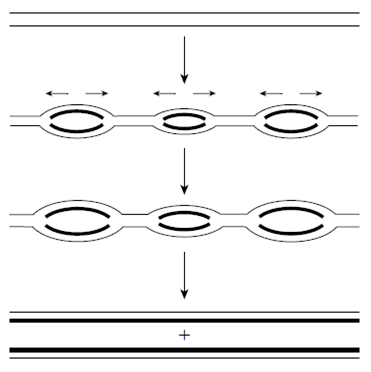Semi-conservatively
Replication of each linear DNA molecule in a chromosome begins at several origins, one every 30-300 kb of DNA depending on the tissue and species and proceeds bi-directionally from every origin. The use of multiple origins is essential in order to ensure in which the large amount of chromosomal DNA in a eukaryotic cell is replicated within the necessary time period. At every origin a replication bubble forms consisting of two replication forks moving in opposite directions. The DNA replicated under the control of a single origin is known a replicon. The DNA synthesis proceeds until replication bubbles merge together.
All of the regions of a chromosome are not replicated concurrently. Rather, several replication eyes will be established in one part of the chromosome and none in

figure: Replication of eukaryotic chromosomal DNA. Replication begins at many origins and proceeds bi-directionally at each location. Eventually the replication eyes merge together to produce two daughter DNA molecules, each of which consists of one parental DNA strand (thin line) and one newly synthesized DNA strand (thick line) Another section. Thus replication origins are activated in clusters, called replication units, consisting of 20-80 origins. During S phase, the different replications units are activated in a set order until eventually the whole chromosome has been replicated. Transcriptionally-active DNA appears to be replicated early in S phase, whilst chromatin that is condensed and not transcriptionally active is replicated later.